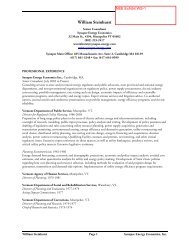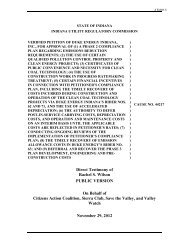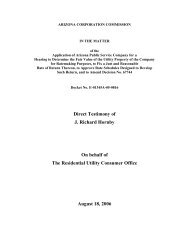Best Practices in Energy Efficiency Program Screening - Synapse ...
Best Practices in Energy Efficiency Program Screening - Synapse ...
Best Practices in Energy Efficiency Program Screening - Synapse ...
You also want an ePaper? Increase the reach of your titles
YUMPU automatically turns print PDFs into web optimized ePapers that Google loves.
3. Calculation of Avoided Costs<br />
<strong>Energy</strong> efficiency programs result <strong>in</strong> several types of avoided costs, and it is important<br />
that all of them are <strong>in</strong>cluded <strong>in</strong> the screen<strong>in</strong>g analysis and that each of them is calculated<br />
correctly. This section provides an overview of the proper techniques for estimat<strong>in</strong>g<br />
avoided costs. Proper estimation of avoided costs requires many important analytical<br />
techniques that are beyond the scope of this study. Readers are encouraged to refer to<br />
the reference documents for more details.<br />
3.1 Introduction<br />
The typical approach for quantify<strong>in</strong>g the benefits of energy efficiency is to forecast longterm<br />
avoided costs, def<strong>in</strong>ed as costs that would have been spent if the energy efficiency<br />
sav<strong>in</strong>gs measure had not been put <strong>in</strong> place. In addition, the utility may not have to<br />
purchase as much system capacity, make as many upgrades to distribution or<br />
transmission systems, buy as many emissions offsets, or <strong>in</strong>cur as many other costs. All<br />
such cost sav<strong>in</strong>gs result<strong>in</strong>g from efficiency are directly counted as avoided cost benefits.<br />
(NAPEE 2007, Section 3).<br />
There are two ma<strong>in</strong> categories of avoided costs: energy-related and capacity-related<br />
avoided costs. <strong>Energy</strong>-related avoided costs <strong>in</strong>volve market prices of energy, losses,<br />
natural gas commodity prices, and other benefits associated with energy production<br />
such as reduced air emissions and water usage. Capacity-related avoided costs <strong>in</strong>volve<br />
<strong>in</strong>frastructure <strong>in</strong>vestments such as power plants, transmission and distribution l<strong>in</strong>es,<br />
pipel<strong>in</strong>es, and liquefied natural gas (LNG) term<strong>in</strong>als (NAPEE 2007, Section 3).<br />
Nationwide, states use different methodological approaches as the basis for their<br />
avoided costs. Twelve states use essentially fixed values based on an assumed “next<br />
power plan,” eleven states based them on a more sophisticated model<strong>in</strong>g of average or<br />
marg<strong>in</strong>al system costs, twelve states used some market price based methodology, and<br />
three states used some other methodology (ACEEE 2012, p.32).<br />
3.2 Avoided <strong>Energy</strong> Costs<br />
When estimat<strong>in</strong>g avoided energy costs it is important to consider the relevant market<br />
structure. For those utilities that participate <strong>in</strong> competitive wholesale markets, a forecast<br />
of market prices should be used to estimate avoided costs. For vertically <strong>in</strong>tegrated<br />
utilities that do not participate <strong>in</strong> competitive wholesale markets, <strong>in</strong>tegrated resource<br />
plann<strong>in</strong>g approaches should be used to estimate avoided costs.<br />
If energy market prices are used to estimate avoided energy costs, then these market<br />
prices must be forecast for as many years <strong>in</strong>to the future as necessary to cover the<br />
entire study period. (See Section 5.2 for a discussion of the appropriate study period to<br />
use.) In a wholesale electricity market context, the market price is equal to the marg<strong>in</strong>al<br />
cost of operat<strong>in</strong>g enough generation units to meet demand <strong>in</strong> each hour of the year. This<br />
marg<strong>in</strong>al energy cost can vary significantly between peak and off-peak hours and<br />
seasons, and is likely to change over time <strong>in</strong> response to chang<strong>in</strong>g demands, chang<strong>in</strong>g<br />
fuel prices, plant retirements and plant additions.<br />
Integrated resource plann<strong>in</strong>g approaches typically require develop<strong>in</strong>g two long-term,<br />
optimized electricity scenarios, one without energy efficiency programs and one with,<br />
| 22 <strong>Best</strong> <strong>Practices</strong> <strong>in</strong> <strong>Energy</strong> <strong>Efficiency</strong> <strong>Program</strong> Screen<strong>in</strong>g | www.nhpci.org







